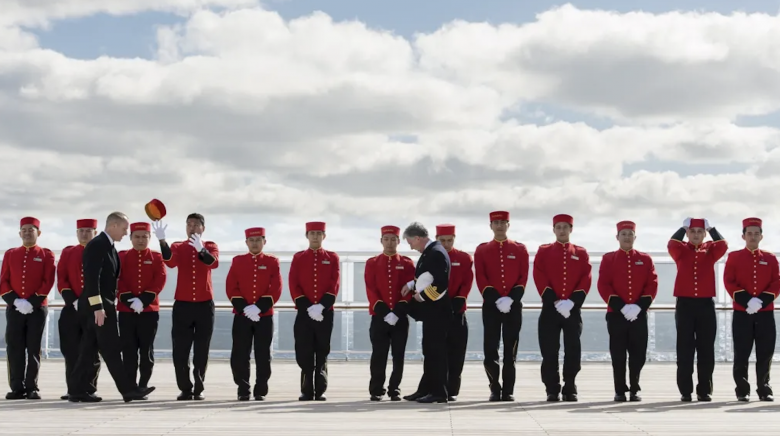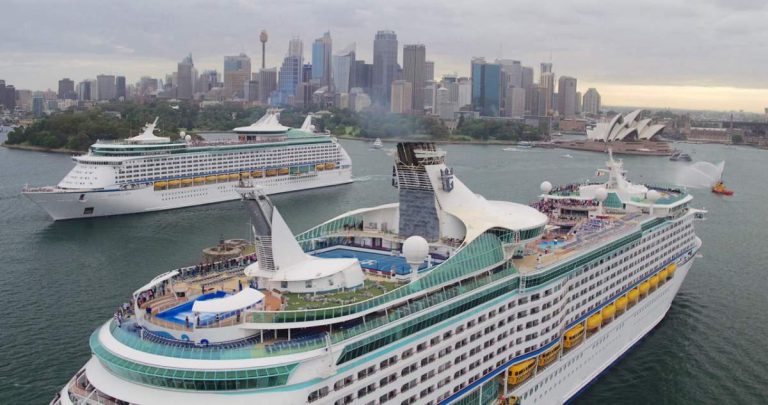The upcoming Australian cruise season is seemingly hanging by a thread following the federal government’s failure to produce a plan for the return of cruising.
Royal Caribbean, which was to have had four ships, Serenade, Radiance, Ovation and Quantum of the Seas homeported in Australia when the wave season was to have started in September, has told Cruise Passenger the deployment is under a “full review”.
A spokesperson said: “In response to the Australian Government’s extension of the international cruise ban, we are currently completing a full review of our upcoming summer program and will announce any necessary changes in the coming weeks. As the Cruise Lines International Association said yesterday, we urge the government to commence discussions with the industry to take real steps towards establishing a plan for future cruise operations.”
Carnival, which homeports the biggest fleet with some nine vessels under the P&O, Princess and Carnival Cruises brands, declined to affirm it would have all ships and brands sailing.
Said a spokesperson: “We continue to press for a plan to enable the resumption of domestic cruising. In the absence of a plan, future planning is extremely difficult. On this basis, we are not in a position to respond specifically other than to say we look forward to a plan to give cruise lines and their guests greater certainty.”
The statements came ofter Cunard and Seabourn both cancelled their anticipated visits to Australia this year.

The cruise ban was extended to September 17 last week in a move that infuriated cruise line chiefs who had anticipated the government would publish a way forward before extending the ban. Such a move would have at least given the industry hope and certainty, while ensuring passengers knew what to expect.
Instead, the government – which appears in disarray after Tourism Minister Dan Tehan spoke of cruises return last month – has ensured that a lack of certainty continues to cast a huge shadow over $6 billion of jobs and income for producers and tourism operators.
Mr Tehan had promised a review of the ban saying: “My hope is if we can continue managing the pandemic like we are, we will be able to see more cruise ships in our waters.”
The sticking point is a federal government “framework,” which without none of the states can hold meaningful talks.
The last two weeks appear to have ignited renewed protest from cruise ship operators, who now seem determined to take the fight for a cruise resumption up to the government.
 “Six of our 12 small expedition ships operating in Europe this month and no progress on a Framework for Staged Resumption in Australia – despite months and months of meetings with Governments. It is unacceptable to stop an entire industry from working when the health protocols are proven, recorded and the risks manageable.
“Six of our 12 small expedition ships operating in Europe this month and no progress on a Framework for Staged Resumption in Australia – despite months and months of meetings with Governments. It is unacceptable to stop an entire industry from working when the health protocols are proven, recorded and the risks manageable.
It generally takes around 90 days to prepare a large cruise ship to sail. September 17 is 91 days away, which means the clock isn’t just ticking, but it’s about to run out of time.
Pointing up Australia’s failure to tackle the issues of getting cruise back to sailing are the actions of others governments. Cruising is resuming around the world across Asia, Europe and the US, meaning large lines like Royal, Caribbean and Carnival will be forced to move their vessels to where they can take passengers and start making enough to pay off the huge loans they have incurred during the pandemic pause of 14 months.
However, the extension of the ban and the following cancellations from Cunard and Seabourn have crushed this positivity, with Royal Caribbean looking like they could be the next to fall.










There is nothing more to say, except WHY, WHY are we again lagging behind the rest of the world, come on Australia show them we won’t be beaten, Get Vaccinated, and we can travel internationally again….
Safety is the main issue, we are a cruising family and miss like hell the inability to take a cruise. BUT the big issue is corporate dollars against the governments wishes. I feel for the thousands of cruising staff who come from all over the world and their lack of being able to support themselves as well as families in some cases. Our OZ governments have to be supported as they are tasked with our welfare. We are princess high category cruiser people and as I said miss the lifestyle but the talk is, where do the staff come from, how long have they been in isolation, who covers the cost of people on board if they strike a covid problem, will a mask have to be worn in public areas, what are the meal arrangements, can a passenger be able to leave the ship in some of the ports rather than take a ships off ship tour. whilst a lot of what I have asked is just stories abounding in the public arena, no one from any company has stated any plans of what is going to happen. How about a transparent outline of the future of cruising is really required. I really wish the shipping companies well as us ourselves. good luck to all.
There should be NO cruising in Australia this year we dont want another Ruby Princess on our door step . When they do resume it should be for vaccinated passengers only
Hi my name is Lola ziyat my 2 bookings ID no’ is 4244038 as I receive and read carefully about your cruising efforts I’m so sorry to that you can’t do nothing about it. it is the Australian government to dicide to open the borders for travelers. so please can you replace my vauchers to cash because my grandson enrolled in university and I will be closer to 80 years old and my insurance will not insure me for traveling.
please can you refund me the amount of 900 American dollars. and believe me I will be the first to cruise ur beautiful ships. I must tell you that I’m on highest membership in princess cruises and I also had booking with them and they refunded me all of it I would love to cruise again so is a lot of people like me.
thank you sincerely Lola Ziyat
I have a cruise booked for December this year . Will be disappointed if it does not go ahead . Surely if crew &passengers have had there vaccination & crew tested can’t see a problem.
I believe the resumption of cruising (domestic and international) depends upon many factors. Right now the major one is the progress of the vaccination program. For many reasons that has been slow and will continue to be slower than desired. 1. Delays in contracted supplies. 2. Fears of risks.
Wow I can’t believe the ship cruise industry’s take on this. If there are problems with proximity infections in CBD quarantine/isolation hotels on land, especially with the more virulent strains of Covid-19, then surely the close-quartered
cruise shipp accommodation is a disaster waiting to happen. If the ‘polies’ give way to this demand, then send the national cabinet meeting off on a 10 day cruise along with returning quarantine expats (from India) and see how that plays out!!
When some one searches for his required thing, therefore
he/she wishes to be available that in detail, so that thing is maintained over here.
I think the government wants people to holiday in Australia and not go cruising. I have travelled all over Australia and more than once and I now prefer to go cruising plus holidaying in Australia is too expensive. I saw an ad for around 7 days travelling by bus to one of the Australian regions and they wanted over $6,000 per person, come on I can book a nice cruise for 17 days including pretty much everything for less than that.
Bring back the cruise ships and everyone should get vaccinated soon as they can so we can get back to some normality, I’m sick of wearing masks, being in lockdowns because an incompetent government is too slow to shut boarders when a state has an out break, workers in quarantine hotels going clubbing, cafe’s, gyms, etc, after work instead of quarantining after work.
If we have to quarantine because we might have and the word is might have come into contact with that infected person in a club or café etc then why are these quarantine workers who are in direct contact with overseas people in the hotels allowed to go clubbing, gyms, cafes without quarantining for a few days first. Fed up!
Personally my husband and I cant wait for the cruises to start up. We are both vaccinated.
My husband has Parkinson’s and it is the easiest way for us to travel and this has been our favorite way to travel for many years. We have in fact done over 70 cruises and thoroughly enjoyed every one of them.
As we get older we want to keep travelling and the cruise lines make it easy for us to do just that.
I wish they would go further afield we have done a 3 month cruise for Sydney to Sydney and it was amazing.
So hopefully our government will come to the party sooner than later.
It goes with saying the many people that are involved with this that provide all the food, wine etc and employees of the cruise ships need to be taken into account they have suffered enough.